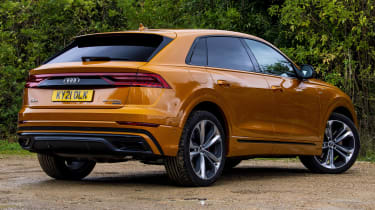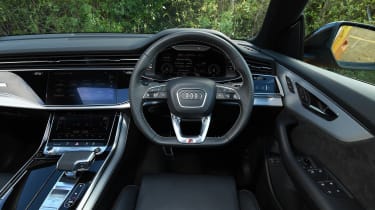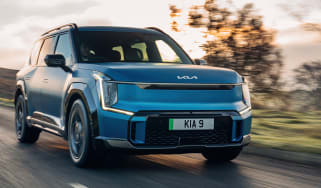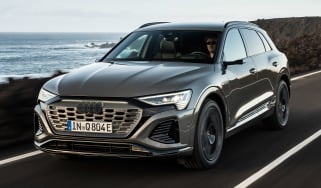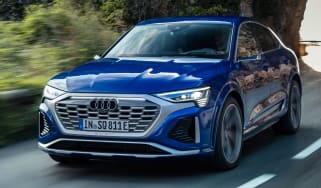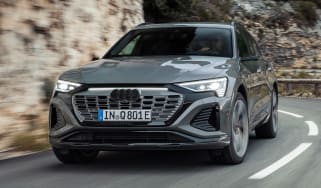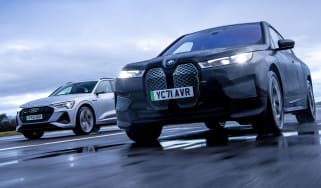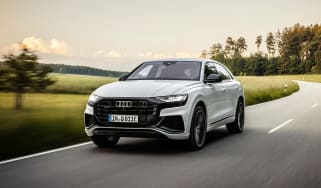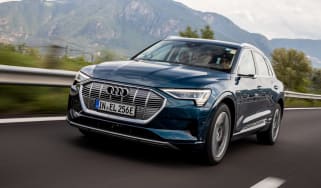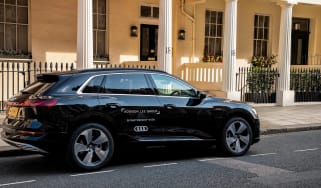Audi Q8 hybrid review
The most expensive Audi plug-in hybrid SUV you can buy, the Q8 TFSI e promises to be a sportier equivalent to its boxier Q7 counterpart
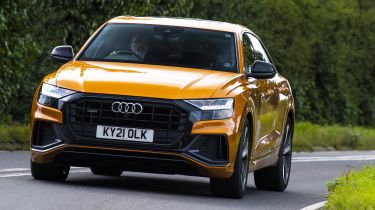
Pros
- High-quality interior
- Sleek and sporty looks
- Both powerful and efficient
Cons
- Not very involving to drive
- Practicality reduced further by battery
- BMW X5 is cheaper and more efficient
| Car type | Electric range | Fuel economy | CO2 emissions |
|---|---|---|---|
| Plug-in hybrid | 28 miles | 97mpg | 66g/km |
A large coupe-SUV like the Audi Q8 can seem a bit counter-intuitive. If one of the main reasons for buying a vehicle of this size is to maximise interior space, why would you go lopping half the boot off with a rakish rear hatch? The car-buying public doesn't agree, however: coupe versions of popular SUVs – both electric and combustion-engined – have sprung up like mushrooms in recent years, in response to big demand.
The Q8 is the coupe equivalent of the more familiar Q7, and evidently Audi thought it special enough to give its own nameplate, instead of just calling it the 'Q7 Sportback'. You can still buy one with a '50 TDI' diesel or '55 TFSI' petrol engine, but, this being DrivingElectric, we're concentrating on the '55 TFSI e' plug-in hybrid.
As the number suggests, it's slightly more powerful than the '50 TFSI e' setup used in the A6 saloon, A7 hatchback, Q5 SUV and even the closely related Q7. Total power output is 375bhp, with a 3.0-litre turbocharged V6 engine working in tandem with a single electric motor, drawing power from a 17.9kWh battery. (An even more powerful '60 TFSI e' option was previously offered in the Q8, but that's now confined to the A8 luxury limousine.)
Working on its own, the 134bhp electric motor also generates 400Nm of torque. That means it's more than sufficient to haul this big car around at lower speeds without the engine getting involved. Some plug-in hybrids struggle to offer enough power or range in electric mode to make truly fuel-free commuting possible, but it's definitely an option in the Q8. Bring the engine into play and an impressive 5.8-second 0-62mph time, along with truly unruffled motorway cruising, are possible.
Throttle response is sharper than in the purely petrol Q8, if not quite as instantaneous as in one of Audi's pure-electric e-tron models. In common with most big and beefy SUVs, it struggles to offer any sense of agility or involvement from behind the wheel. There's no disguising its almost-2,500kg weight when you're trying to attack a series of bends, although it does at least remain stable and grippy in such situations, with precise if numb steering that makes it easy to place on the road.
Back on the daily commute, there's no doubt the Q8 will prove significantly cheaper to run than its purely diesel or petrol-fuelled brethren. The official economy number is not far off 100mpg, and we even managed to exceed that on a 30-mile run that began with a fully charged battery and took in a fair amount of steady motorway cruising. Travel for a significant distance with no charge in the battery and that number will fall, of course, but when you match this capability to a very low company-car tax band, the savings quickly add up.
That is, of course, in the context of some pretty high list prices. The range starts at just under £76,000 for the S line, sporting 21-inch alloys, matrix LED headlights, air suspension, leather upholstery and a three-screen infotainment and driver display setup. Next up is the Black Edition, coming in a shade under £80,000. This gets you larger 22-inch wheels, a black styling pack (seen in our pictures) and polished wood inlays inside.

The range-topping Vorsprung gets perilously close to six figures, but does add heaps more equipment, such as a 360-degree parking camera, a head-up display, a Bang & Olufsen sound system, ventilated and massaging front sports seats, plus a comprehensive driver-assistance package.
In isolation, then, the Q8 hybrid is a pretty appealing package, offering head-turning sports SUV looks combined with sumptuous interior luxury and impressively low running costs. It falls down slightly in comparison with rivals, though: the BMW X5 xDrive45e is pretty much as powerful, but has a larger battery for a significantly longer electric range of over 50 miles, so it'll be even cheaper to run as a company car.
And the Q8 takes a double hit when it comes to practicality. The model's boot is already smaller than that of the Q7 on which it's based, but adding the hybrid's batteries robs you of another 100 litres' luggage capacity, taking the total down to 505 litres. Whether the tradeoff is worth it for those svelte looks is up to you.

